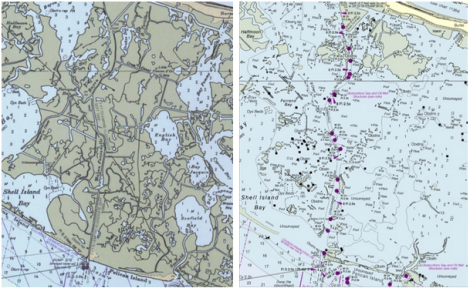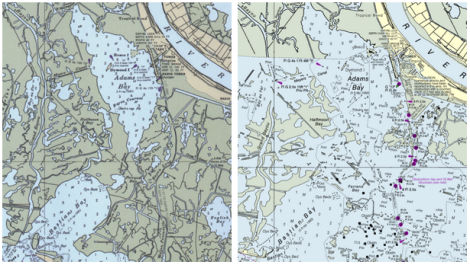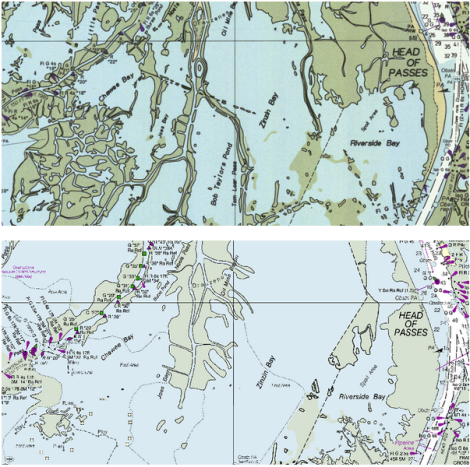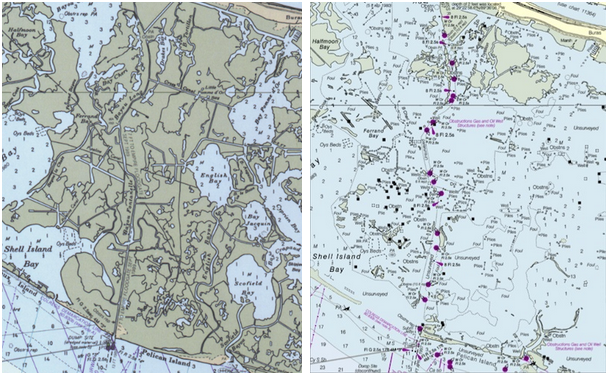Twenty-five years ago, miles of marshy land and grasses separated the small fishing outpost of Buras, La., from the Gulf of Mexico. But years of erosion — along with the one-two punch of Hurricanes Katrina and Rita — have washed away much of that barrier. Today, the islands, inlets, and bays that once defined the coastline of Plaquemines Parish have begun to melt together.
Like all coasts, the land around the Mississippi River is constantly evolving. In past centuries, that process was slowed by the annual flooding of the river’s vast delta, which brought new sediment to replace what was lost.
But climate change, coupled with better engineering (which brought effective channeling and stronger levees), has turned this coastline into one of the most rapidly eroding areas of the U.S. In the area around Buras, gone are the formerly distinct waterways of English Bay, Bay Jacquin, and Scofield Bay, leaving a vast expanse of water between the mainland and the barrier islands.

NOAAThe area south of the town of Buras, Louisiana, in 1990 (left) and today (right). NOAA has retired the names English Bay, Bay Jacquin, and Scofield Bay, acknowledging the vast water that now separates Buras from the barrier along Pelican Island. Click to embiggen.
Each year, this part of the coastline loses around 16 square miles of land, according to David Muth, the state director of the National Wildlife Federation’s Mississippi River Delta Restoration Project. And until quite recently, even the most advanced maps of the area did little to reflect the changing environmental reality.
But in the last few years, renewed mapping efforts from the National Oceanic and Atmospheric Administration have begun to catalog these changes. These new maps show water where there was once marshy land, and bays where there were once small inlets.
And in the last few years, more than 30 of the region’s names — including English Bay, Bay Jacquin, and Scofield Bay — have been officially retired from the map. Meredith Westington, chief geographer at NOAA’s Office of Coast Survey, keeps a running list of these newly extinct places handy on her desk. Though communities have become attached to the names of their nearby landscape, she explains, that it just “doesn’t make sense to leave some island name in the chart where there’s no island there anymore.”

NOAACoastal erosion has dramatically changed the size and shape of Adams Bay and Bastian Bay, once far more distinct waterways. Click to embiggen.
These marshy regions of coastal Louisiana aren’t normally the types of areas that attract close attention from NOAA, which focuses on larger ports with more significant commercial navigation traffic. But following Katrina and Rita, reports of debris prompted an unusual amount of new surveying efforts, according to Mike Espey, who oversees these projects as the chief of the Applications Branch of the Remote Sensing Division of NOAA’s National Geodetic Survey.
In the old days, mapmakers used on-the-water travel or interviews about local terminology with Bayou fishermen to get the lay of the land. Now, Espey’s office uses a combination of aerial photographs and satellite images to catalog the new geography of this rapidly eroding region.
This, Espey explains, makes it possible to track changes to these tiny and navigationally insignificant areas. Since much of the surveyed land is marshy and ill-defined, these maps tend to mark where vegetation has stopped growing, more than anything else. The changes to these most recent charts are still nowhere near the finest scale of detail possible.
Still, the land loss we can see is stark. “You’re kind of seeing a culmination of decades of changes,” Westington says. “And it looks very dramatic.”
In many cases, the names lost forever from the maps represent places that have long since ceased to exist. “You’re cruising along and the water will be three, four feet deep, and the GPS will say you’re on land,” Muth says. “The official maps are really trying to catch up, but land loss is so fast in certain parts of the coast that no one can keep up. You can have a piece of land out there that retreats 20, 30, 40 feet a year.”

NOAABob Taylors Pond, one of the names officially put on the historical list, has become a part of Zinzin Bay. Click to embiggen.
The latest surveys are still being processed, and already Westington’s office has decided to retire 10 additional names that appear on even NOAA’s most recent set of charts. And future changes to the landscape could alter these maps even more. Soon, far larger bodies of water — like the several-miles-across Barataria Bay and Terrebone Bay — may lose their natural barriers and combine. And land rebuilding efforts, outlined in the state’s 2012 Coastal Master Plan, could lead to new deposits of sediment, and eventually new land, in other parts of the river’s vast delta.
No matter what, the map will certainly change again. “Because deltas are so dynamic, they’re either building or they’re eroding,” Muth says. “The idea that you can pick a point in time and say, ‘This is how we want the coast to look,’ is, first of all, the wrong way to think about it. And second of all, it creates an impossible situation.”
 This story was produced by Atlantic Cities as part of the Climate Desk collaboration.
This story was produced by Atlantic Cities as part of the Climate Desk collaboration.


